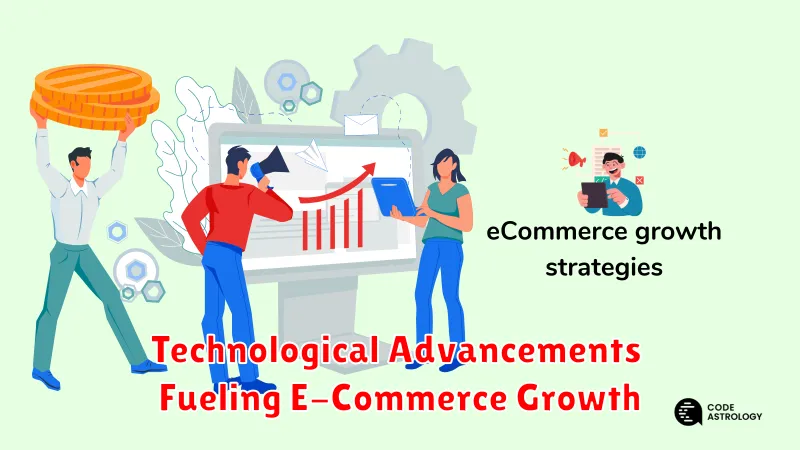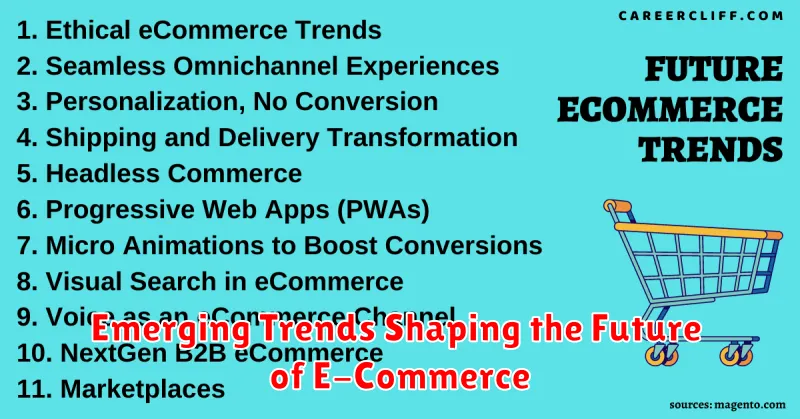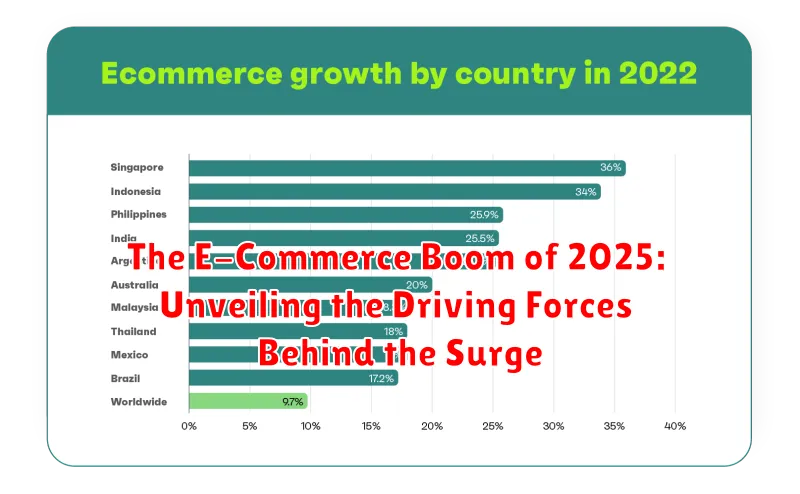The year 2025 promises to be a pivotal one for e-commerce, marking a significant surge in online retail activity. This anticipated e-commerce boom is driven by a confluence of factors, transforming the way businesses operate and consumers shop. Understanding these driving forces is crucial for businesses seeking to thrive in this rapidly evolving digital landscape. This article will delve into the key trends shaping the e-commerce landscape of 2025, exploring the technological advancements, changing consumer behaviors, and market dynamics fueling this extraordinary growth. From the rise of mobile commerce and the pervasive influence of social media to the increasing sophistication of artificial intelligence and the growing demand for personalized experiences, we will unveil the forces behind the e-commerce surge.
The e-commerce boom of 2025 presents both unprecedented opportunities and challenges for businesses. Staying ahead of the curve requires a deep understanding of the evolving e-commerce trends. This article will provide valuable insights into the key drivers of this e-commerce growth, enabling businesses to adapt their strategies and capitalize on the emerging potential of the online marketplace. We will examine the impact of augmented reality and virtual reality on the shopping experience, the growing importance of sustainable and ethical e-commerce practices, and the evolving role of logistics and supply chain management in meeting the demands of this burgeoning online market.
Understanding the Shift to Online Shopping
The shift towards online shopping isn’t a sudden phenomenon but rather a gradual evolution influenced by several key factors. Convenience plays a crucial role, allowing consumers to shop from anywhere, anytime, eliminating the need for travel and fixed store hours.
Increased product selection is another driving force. E-commerce platforms offer a vastly wider range of products compared to traditional brick-and-mortar stores, catering to diverse needs and preferences. This expanded choice empowers consumers to find precisely what they’re looking for, often at more competitive prices.
Enhanced price transparency allows shoppers to easily compare prices across different retailers, fostering competition and enabling more informed purchasing decisions. This contributes to the perception of value and cost savings, further incentivizing online shopping.
Technological Advancements Fueling E-Commerce Growth

The e-commerce boom of 2025 is significantly driven by rapid technological advancements. These innovations are not only enhancing the online shopping experience but also streamlining operations for businesses, making e-commerce more accessible and efficient.
Artificial intelligence (AI) plays a crucial role. AI-powered personalization engines analyze customer data to recommend products and tailor shopping experiences. Chatbots provide instant customer support, while AI-driven logistics optimize delivery routes and warehouse management.
The rise of Augmented Reality (AR) and Virtual Reality (VR) technologies allows customers to virtually try on clothes or visualize furniture in their homes before purchasing. This immersive experience bridges the gap between online and offline shopping, reducing purchase hesitation.
Furthermore, advancements in blockchain technology are enhancing security and transparency in online transactions. Blockchain facilitates secure payment processing and supply chain management, building trust between businesses and consumers.
The Impact of Mobile Commerce on the 2025 Boom
Mobile commerce, or m-commerce, plays a pivotal role in the projected e-commerce surge of 2025. The ubiquitous nature of smartphones and increasing mobile internet penetration are key drivers. Consumers are increasingly comfortable browsing, comparing, and purchasing products directly from their mobile devices.
Improved mobile user interfaces, streamlined checkout processes, and the rise of mobile payment options contribute significantly to m-commerce growth. The ability to shop anytime, anywhere empowers consumers and fosters impulse purchases, further driving sales.
In-app shopping experiences within social media platforms and dedicated retail apps also contribute to the m-commerce boom. These platforms offer targeted advertising and personalized recommendations, creating a seamless and engaging shopping journey for users.
The convenience and accessibility of mobile commerce are transforming the retail landscape and are projected to be a dominant force in the 2025 e-commerce expansion.
Changing Consumer Behavior and Expectations
The e-commerce boom of 2025 is significantly shaped by evolving consumer behavior and rising expectations. Convenience has become paramount, with shoppers prioritizing seamless and efficient online experiences. Consumers now expect personalized recommendations and targeted advertising, driving the need for sophisticated data analysis and AI-powered marketing strategies.
Demand for faster delivery has intensified, pushing retailers to optimize logistics and offer same-day or next-day shipping options. This has led to the growth of micro-fulfillment centers and innovative delivery models. Furthermore, consumers are increasingly prioritizing sustainable practices, favoring brands that demonstrate ethical sourcing and environmentally friendly packaging.
Transparency and trust are also crucial. Consumers expect clear product information, honest reviews, and secure payment gateways. Brands that prioritize building trust through open communication and reliable customer service are more likely to thrive in this evolving landscape.
The Rise of Social Commerce and Influencer Marketing
Social commerce has emerged as a powerful force, seamlessly integrating shopping experiences within social media platforms. This trend is expected to significantly contribute to the e-commerce boom of 2025.
Influencer marketing plays a key role in this growth. By leveraging the trust and engagement built by influencers with their followers, brands can effectively reach target audiences and drive sales directly through social media channels.
Platforms like Instagram, TikTok, and Facebook are increasingly incorporating shopping features, allowing users to discover and purchase products without leaving the app. This streamlined process contributes to impulse buying and fosters a more engaging shopping experience.
The ability to target specific demographics through influencer collaborations makes social commerce a highly effective marketing strategy. The personalized recommendations and authentic content from trusted influencers resonate deeply with consumers, fostering brand loyalty and driving conversions.
The Role of Personalized Experiences in E-Commerce Success
In the evolving landscape of e-commerce, personalized experiences have become a critical factor in driving success. Tailoring the online journey to individual customer preferences is no longer a luxury but an expectation.
Personalization encompasses various strategies, including product recommendations based on browsing history and past purchases. By analyzing user data, businesses can effectively predict future needs and desires, presenting relevant items at the optimal time.
Targeted advertising is another key element. Displaying ads for products that align with a customer’s interests increases engagement and conversion rates. This personalized approach ensures that marketing efforts are more efficient and resonate with the intended audience.
Furthermore, personalized email marketing campaigns play a vital role. Addressing customers by name and offering exclusive deals based on their individual profiles fosters a sense of loyalty and encourages repeat business.
Ultimately, personalization enhances customer satisfaction and builds stronger relationships between consumers and brands. By catering to individual needs and preferences, businesses can create a more engaging and rewarding shopping experience that drives sales and cultivates lasting customer loyalty.
Emerging Trends Shaping the Future of E-Commerce

Several key trends are poised to reshape the e-commerce landscape in the coming years. Augmented Reality (AR) and Virtual Reality (VR) are moving from novelty to essential tools, allowing customers to visualize products in their own homes or even “try on” clothes virtually. This immersive experience bridges the gap between online and in-store shopping.
Artificial intelligence (AI) is also playing a crucial role. AI-powered chatbots provide instant customer service, personalized recommendations enhance the shopping journey, and predictive analytics optimize inventory management and logistics. These advancements lead to increased efficiency and customer satisfaction.
The rise of social commerce is blurring the lines between social media and online shopping. Platforms are integrating shopping features, allowing users to discover and purchase products directly within their social feeds. This seamless integration simplifies the buying process and leverages the power of social influence.
Finally, sustainable e-commerce is gaining momentum. Consumers are increasingly prioritizing eco-friendly brands and practices. Businesses are responding by adopting sustainable packaging, optimizing shipping routes to reduce emissions, and offering carbon-neutral delivery options.

